
|
|

November 17, 2006
Black Mountain, Las Vegas, Nevada
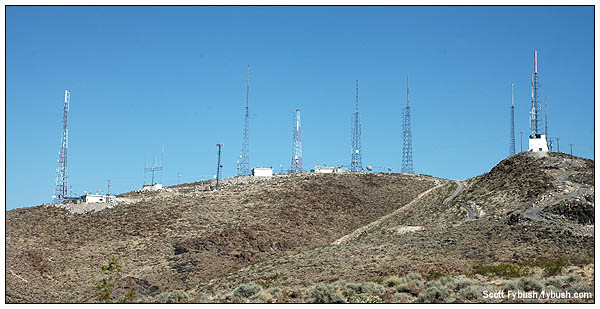 This
month, we're kicking off a brand-new season of sites that have
never before been seen on Tower Site of the Week - and last week
found us up on Mount
Potosi outside Las Vegas, another one of the sites featured
in Tower Site Calendar
2007.
This
month, we're kicking off a brand-new season of sites that have
never before been seen on Tower Site of the Week - and last week
found us up on Mount
Potosi outside Las Vegas, another one of the sites featured
in Tower Site Calendar
2007.
This week, it's another Las Vegas mountaintop site that you'll see in a future Tower Site Calendar someday.
If you've ever looked to the south as you're landing at McCarran International Airport, you've probably seen the ridge that rises up right in the middle of suburban Henderson, crowned with two clusters of towers. The whole thing is known, generally, as "Black Mountain," but the local engineers in Las Vegas reserve that name for the group of towers at the northern end of the ridge, which is the site we're featuring this week. (We're still waiting for an invitation - hint, hint - to go up to the separate cluster of towers to the south, known as Mount Arden, that's home to KLAS-TV, KTNV and several UHF stations, as well as a lone full-power FM, KSTJ 102.7 Boulder City.)
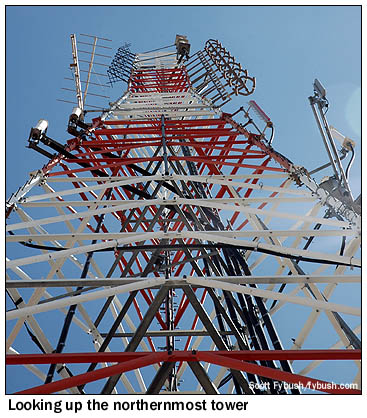
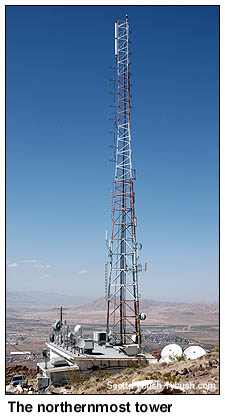 Our
introduction to Black Mountain came on the Saturday of the NAB
Show this past April, when Clear Channel's local chief engineer,
Tree Lee, led what I can only describe as a "corporate field
trip" up the mountain for a big group of executives (including
corporate engineering chief Steve Davis) and friends.
Our
introduction to Black Mountain came on the Saturday of the NAB
Show this past April, when Clear Channel's local chief engineer,
Tree Lee, led what I can only describe as a "corporate field
trip" up the mountain for a big group of executives (including
corporate engineering chief Steve Davis) and friends.
At one time, getting up Black Mountain was probably a pretty long haul from Las Vegas, but the relentless encroachment of suburbia has changed all that. Today, the access road up the hill comes right off a major four-lane road in Henderson, and as development keeps edging its way up the northern slope of the mountain, the gate will probably keep moving uphill.
(I'm told the situation over at Mount Arden is even more fluid, with new road construction constantly changing the access to the road up to the summit.)
In any event, the character of the road changes pretty quickly once we pass beyond the gate and start heading uphill, leaving urban Las Vegas behind and bumping our way up a narrow, steep road that crosses several saddles with dramatic drop-offs before arriving at the peak of the mountain, where it forks to reach two clusters of towers arranged roughly in an "L" shape, which you can see pretty clearly in the photo at the top of the page, which shows the towers from north to south. From left to right, we see the KBLR (Channel 39) tower, the KVBC (Channel 3) tower, the three towers associated with Building 4 (the main FM building), and then, off to the right, the cluster of towers that form the southern end of the "L," which we'll return to later.
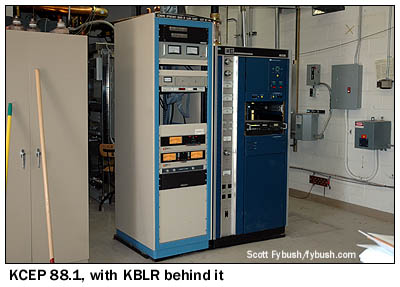
|
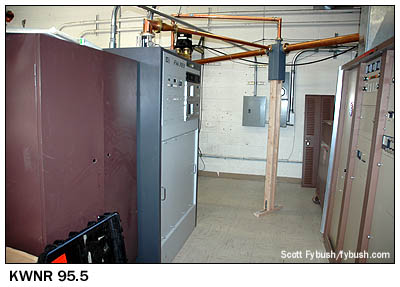
|
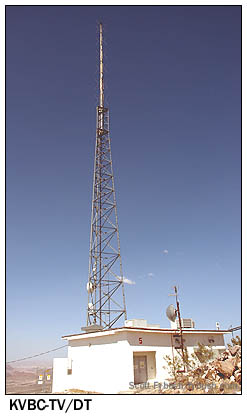 Our
tour begins at the northernmost tower and transmitter building
on the mountain, which houses two full-power FM stations, KCEP
(88.1), licensed to the Economic Opportunity Board of Clark County,
and KWNR (95.5), Clear Channel's country monster.
Our
tour begins at the northernmost tower and transmitter building
on the mountain, which houses two full-power FM stations, KCEP
(88.1), licensed to the Economic Opportunity Board of Clark County,
and KWNR (95.5), Clear Channel's country monster.
That's KWNR's brand-new BE digital rig in the middle of the photo above at right, and a nifty feedline/coax switch configuration, too. This building also houses a 20 kW FM booster, KVEG-1, which provides an in-city signal for KVEG (97.5 Mesquite), a big class C signal that serves a whole lot of empty desert 60 miles or so northeast of the city. (I'm pretty sure the KVEG-1 antenna is the Yagi in the upper left corner of the straight-up-the-tower shot above.)
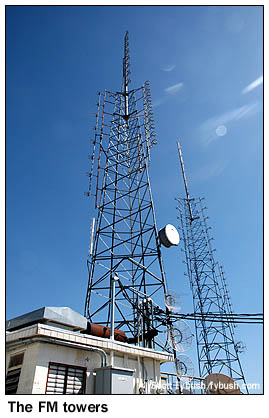 The
KBLR tower actually sits down a steep slope from the rest of
the ridge, so it's an uphill climb heading south to the next
tower in the cluster. "Building 5" on Black Mountain
houses Las Vegas' NBC affiliate, KVBC (Channel 3), which actually
began its career on the air as a Henderson-licensed station,
signing on in 1955 as KLRJ-TV on channel 2. (The calls stood
for the Las Vegas Review-Journal, which then owned the
station.)
The
KBLR tower actually sits down a steep slope from the rest of
the ridge, so it's an uphill climb heading south to the next
tower in the cluster. "Building 5" on Black Mountain
houses Las Vegas' NBC affiliate, KVBC (Channel 3), which actually
began its career on the air as a Henderson-licensed station,
signing on in 1955 as KLRJ-TV on channel 2. (The calls stood
for the Las Vegas Review-Journal, which then owned the
station.)
KLRJ evolved into KORK-TV on channel 3, changing city of license to Las Vegas. It split from sister radio stations KORK (920) and KYRK (97.1) in 1979, taking its present KVBC calls under a new owner and a new license. (It wasn't until that point that Channel 3 came up here to Black Mountain from its old low-power facilities on a short tower on Boulder Highway in Las Vegas.)
And, ironically, when KVBC received its DTV assignment, KVBC-DT ended up on channel 2, right back where KLRJ started half a century earlier. As a rare low-band VHF DTV, KVBC-DT was one of the first DTV signals to be successfully DX'ed via E-skip, and is now a semi-regular catch for TV DXers in the midwest during skip season.
Next door to Building 5 is Building 4, which houses most of Black Mountain's FM stations in fairly tight quarters.
Three towers surround Building 4, and with some help from CBS Radio's Tracy Teagarden, I think I can now identify what's on at least two of them, shown above at right. In the foreground is "Tower 2," topped off by Clear Channel's KWID (101.9), which was one of the first FMs on the mountain in the very early 1970s as KFMS.
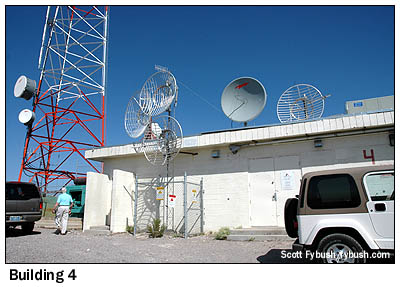 That's
CBS Radio's "Jack FM" KKJJ (100.5 Henderson) on the
eight bays on the left side and CBS Radio's "Mix" KMXB
(94.1 Henderson) on the ten-bay antenna on the right. KUNV (91.5),
the jazz station from the University of Nevada Las Vegas, is
on a three-bay antenna on the back side of the tower.
That's
CBS Radio's "Jack FM" KKJJ (100.5 Henderson) on the
eight bays on the left side and CBS Radio's "Mix" KMXB
(94.1 Henderson) on the ten-bay antenna on the right. KUNV (91.5),
the jazz station from the University of Nevada Las Vegas, is
on a three-bay antenna on the back side of the tower.
"Tower 3" on the right is topped by another veteran signal on the mountain: KSOS (90.5), the religious station formerly known as KILA, which moved to 90.5 from 95.5 in the eighties, clearing the way for the arrival of commercial KWNR on that frequency. CBS radio's top 40 KLUC (98.5) is the eight-bay antenna on the left (north) side of the tower, while KKLZ (96.3), Beasley's classic rock station, is the six-bay Shively on the right side, above another Shively belonging to KISF (103.5), Univision Radio's regional Mexican "La Nueva."
(Yes, as recently as 1989, it was possible to put a brand-new class C FM signal on the air right in Las Vegas; as recently as 1981, there were only two FMs up here at all and only a handful more anywhere in the market, mostly on short towers in the valley.)
I think the last full-power FM up here, Clear Channel's soft AC KSNE (106.5 North Las Vegas) is on the tower just north of building 4, the base of which can be seen in the photo at left.
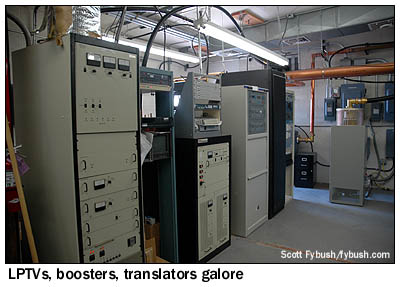
|
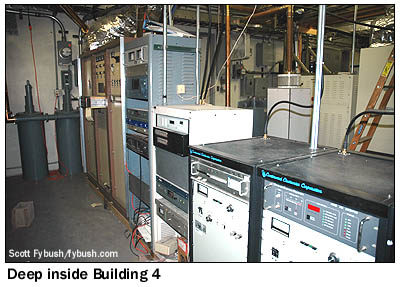
|
Heading inside the building, we find some even newer additions to the mountain. A row of transmitters just inside the door includes two LPTVs, KVPX-LP (Channel 28) and KLSV-LP (Channel 50), plus a high-powered (6 kW) booster for Univision Radio's KRGT-1 (99.3), which no doubt reaches a lot more listeners than the nominal primary, KRGT (99.3 Indian Springs), which sits behind a mountain range 40 miles or so west of Las Vegas. KRGT-1 is the Harris in the middle of the row; at far right is a rack holding one more translator, K257BU Henderson, a 10-watt signal that was displaced from 99.3 when KRGT arrived a few years back. It's now on 98.9, and it fills in some of the in-city coverage issues for the Mount Potosi signal of KXPT (97.1).
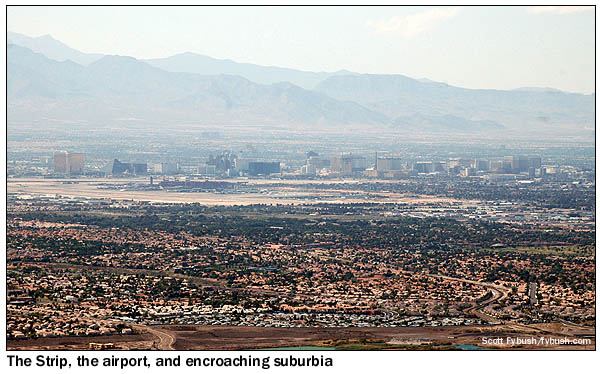 The
row of low-power signals faces the back of the 103.5 transmitter,
which in turn faces KLUC.
The
row of low-power signals faces the back of the 103.5 transmitter,
which in turn faces KLUC.
Perpendicular to all those, several more rows of transmitters and racks fill the rest of Building 4, all the way back to the far wall, where KKJJ (shown above at right) and KMXB are tucked into one corner, next to KUNV, KWID and the KPLV auxiliary transmitter.
Before we move on to the TV towers at the south end of the hill, let's pause for a look down into the valley, where we get a nice aerial view of the Strip, with Mandalay Bay and the Luxor at the left, New York New York and the MGM Grand pretty easily visible at center, and Paris Las Vegas and the Mirage, among others, identifiable at the right. (I'm guessing the view from up here at night must be nothing short of spectacular!) That's McCarran Airport in the foreground, and lots and lots and lots of very new development edging its way up the mountain even closer in. It'll no doubt look different in another couple of years.
We didn't have any tours arranged at the TV stations up here, so the best we can do is show you the towers and the building exteriors. The towers at left belong to KVVU-DT (Channel 9) and KVVU (Channel 5), the market's Fox affiliate. When KVVU signed on in 1967, it was the very first station on the mountain, predating any roads or power lines up here. Next to KVVU is the transmitter building and tower of "Vegas PBS," KLVX (Channel 10)/KLVX-DT (Channel 11), another early arrival. And next to that is a beefy tower that's home to most of Sinclair's Las Vegas signals - KVMY (Channel 21), KVMY-DT (Channel 22) and KVCW-DT (Channel 29). Those, obviously, are the My Network TV and CW affiliates in the market now; when we were last there, they were "WB Las Vegas" KVWB and independent KFBT, respectively. (The KFBT/KVCW analog transmitter on channel 33 is over on Mount Arden, the site we didn't get to; that location is also home to CBS affiliate KLAS 8/DT7, which developed that site in the sixties, and ABC affiliate KTNV 13/DT12. KLAS had been at the Desert Inn, and its studios still sit on "Channel 8 Drive," near the convention center on former Desert Inn property, while KTNV started out as KSHO at the El Rancho casino before moving to the tower behind its present studio site on Valley View Drive and eventually up to Mount Arden in the eighties.)
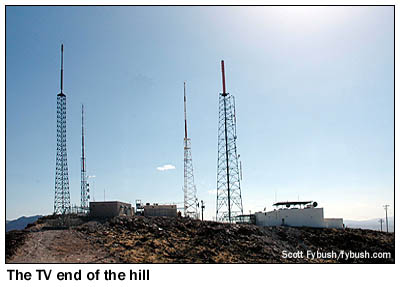
|
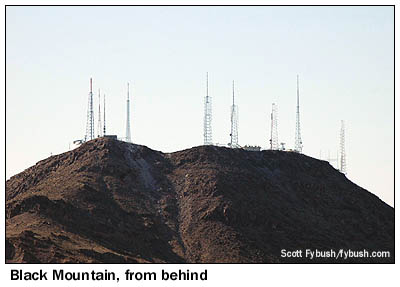
|
One useful advantage to being on Black Mountain is that the stations here have no problem reaching behind Black Mountain, which blocks the Mount Potosi FMs from some fast-growing parts of Henderson along US 93/95 as the highway wends its way south to Boulder City and Hoover Dam.
Above at right is the view from that side of the mountain, showing the TV towers at left, the Building 4 FM towers in the center, then KVBC and a nice view showing how much lower on the hill the KBLR/KWNR tower is situated than the other sticks.
(I'm pretty sure this view was shot from the KLSQ 870 site, which we'll see next week as we continue our Vegas retrospective!)
 Thanks
to Tree Lee of Clear Channel for the tour!
Thanks
to Tree Lee of Clear Channel for the tour!The Tower Site Calendar 2007 is here! It's not just Mount Potosi - but a dozen more great photos of transmitter sites near and far. Be one of the first to receive your copy - order today at the Fybush.com Store!
- Previous Site of the Week: Mount Potosi, Las Vegas, NV
- Next Week: KDWN and KLSQ, Las Vegas, NV
- Site of the Week INDEX!
- How can you help support Site of the Week? Click here!
- Submit your suggestions for a future Site of the Week!
